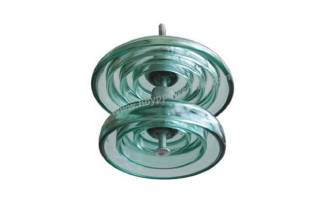5. Flashover problem
Similar to traditional porcelain insulators or glass insulators, composite insulators will also flash along the surface. At present, the reasons for flashover of composite insulators are lightning strike, bird damage, pollution flash and other reasons.
Composite insulator has the largest proportion of lightning flashovers in external insulation flashover accidents, of which 35-110kV lines are particularly prominent. Compared with porcelain insulator strings of the same length, 35-110kV composite insulators Smaller and reduced discharge distance, products with voltage levels of 220kV and above are mostly related to the shortened insulation length of the installation position of the grading ring.

Glass Insulator
Although the number of lightning strikes on composite insulators is greater, it is not more severe than that of porcelain and glass insulator strings. L8J. Composite insulators do not have the problem that the zero value of porcelain insulators is easily struck by lightning, and their success rate of reclosing is also high. For porcelain and glass, good quality composite insulators generally leave only white arc traces after lightning strikes, which do not affect their performance and do not need to be replaced (but you must pay attention to the ablation of the metal fittings at both ends); and porcelain or glass insulators The surface glaze layer may burn or even rupture, and sometimes needs to be replaced. The method to reduce the trip rate of lightning strike is to appropriately increase the length of the composite insulator within the allowable size of the tower window. From the perspective of protecting the composite insulator, you can design both ends of the composite insulator. The arc striking function is added when pressing the ring. At this time, in order not to increase the lightning trip rate of the composite insulator, it is necessary to consider increasing its insulation distance accordingly. Guano flashover accounts for about 27% of the total number of identified flashover composite insulators, ranking first. Two. Now more and more birds prefer to place their nests on high-voltage pole towers in order to avoid interference, which inevitably increases the guano flashover. Possibility: Guano flashover can generally be judged by the presence of bird droppings on the surface of the umbrella skirt and under the tower.
6. Aging of composite insulators
The aging of composite insulators is a matter of great concern to everyone. It is mainly manifested in the irreversible hydrophobic degradation and pulverization of the jacket and the skirt material under the combined effects of humidity, surface discharge, ultraviolet rays, and temperature during operation. , Ablation and decrease in tear resistance. Due to many factors affecting aging, there are no clear results in the international research on aging. The research mainly focuses on the aging mechanism, aging criteria and aging test methods that cause composite insulators to age. The main factors include surface discharge (corona discharge, arc discharge), ultraviolet light, temperature, and pollution. Among them, the surface discharge has a serious effect on the performance of the composite insulator. When the surface field strength of the insulator reaches 0.5, there will be water droplets on the surface of the insulator. Corona discharge occurs.
On the one hand, surface discharge can cause strong oxidation, which directly affects surface properties such as water repellency (industrial corona is commonly used in polyethylene to make it lose water repellency, which is convenient for painting and bonding);
On the other hand, the high temperature generated by the discharge itself can cause chemical reactions inside the polymer, causing the material to ablate. At present, the understanding of the effect of ultraviolet rays on composite insulators has not been unified. Some people believe that ultraviolet rays pass through photo-oxidation and silicon rubber The combination of fillers and other chemical factors can lead to material damage.
At the same time, under the action of strong ultraviolet light, the hydrophobicity of the material will be reduced due to the effect of the surface silicon polymer. Another view is that the effect of ultraviolet light on aging (especially silicone rubber composite insulators) is very small, It is smaller in the case of accumulation of contamination, which can be ignored in the aging test. There are even some research tests that show that ultraviolet rays can promote the recovery of water repellency. The reason for the above differences is the test light sources and test methods There are large differences.
In fact, the aging of silicone rubber under normal conditions can be either a long process or it can occur within 2 to 3 years of operation. It depends on the different pollution environments on the one hand, and the formula and Process. In most areas, silicone rubber has maintained good performance for a long period of time. Field operators should pay attention to the aging life of composite insulators in most areas on the one hand; on the other hand, they should find "premature aging" in a timely manner. Products. Even if there are obvious aging characteristics in operation, composite insulators can still operate safely for a long period of time. Therefore, as long as inspections, observations and regular inspections are performed during operation, a large number of composites will not appear in a short period of time. Insulators cannot be used at the same time, leading to a fatal accident.
+86 319 878 9350
+86 156 1304 7999
+86 319 878 9350
NanYan, DongHuan Road, Shahe, Hebei China
Copyright © Hebei Yipeng Line Equipment Co., Ltd. All Rights Reserved. | Sitemap Powered By 
